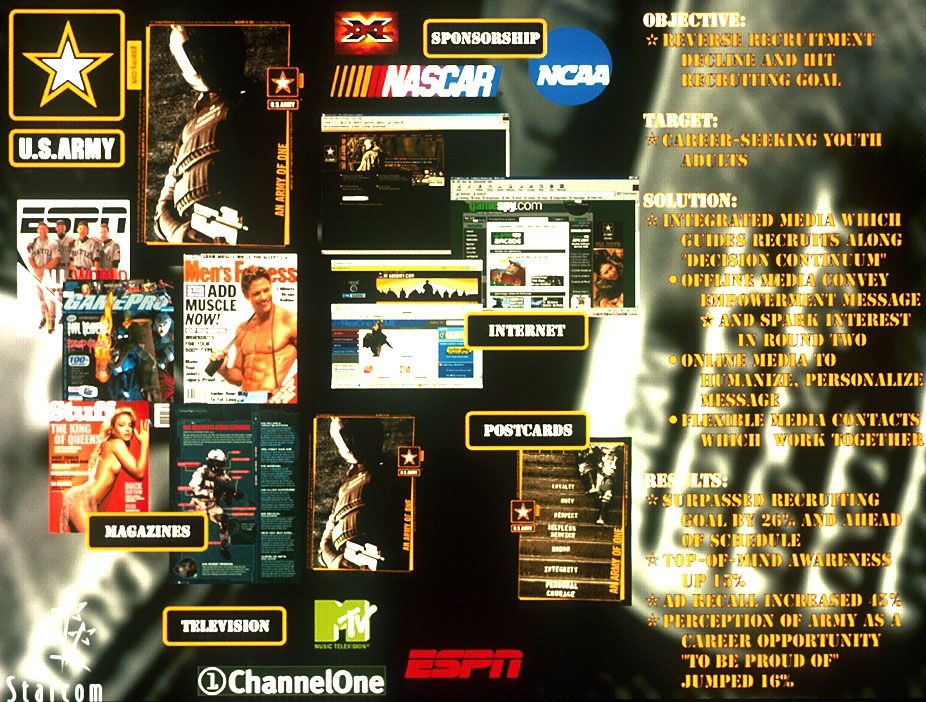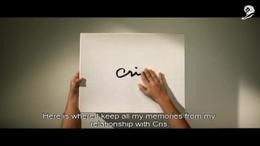Cannes Lions
MILITARY RECRUITMENT
STARCOM MEDIAVEST GROUP, Chicago / UNITED STATES ARMY / 2002

Overview
Entries
Credits
OVERVIEW
Description
Suzanne Meekhof/Starcom IP/Associate DirectorJim Kenyon/Relay Sports Marketing/General ManagerSean Ryan/Starcom Worldwide/Media Supervisor The goal of the campaign was twofold: first, to drive awareness of the Army, its benefits and the opportunities it provides young people, aged 18-24; second, to counteract negative perceptions of the Army. Specifically, the campaign set out to personalize the “Army of One” theme and position the Army as a viable and attractive career option. At the same time, the campaign needed to spark action among its target audience and convert awareness into a visit to the Army’s Web site or, better yet, a recruiter’s office. The plan combines all of the proposed forms of communication and places them in such a manner as to guide recruits along the “Decision Continuum.” This continuum—become aware, become intrigued, seek info, become a lead, purchase, affirm decision—progresses at different times and different speeds for each potential recruit. So this proposed plan had to have the strength and flexibility to reach millions of people, each in their own different stage along the continuum—and impact each one of them in the same manner.The media communicates the campaign’s “Army of One” concept – the Army empowers the individual and team – and the second round called “Basic Training,” which follows six recruits through basic training in near real-time at www.goarmy.com, with a new episode airing each week. Most potential recruits have a PC at home or Internet access at school, so media raised awareness, changed perceptions and then drove them to www.goarmy.com for further information.Drawing on exhaustive research of the target market, the wide mix of media in the campaign was chosen for its ability to support the brand message and to reach the desired audience right where they live, work and play. In addition to that research, the media team developed an Army-specific media questionnaire - which potential recruits filled out in focus groups - that provided invaluable insights into their media usage. TelevisionThe team chose targeted network and cable programs to showcase “Basic Training,” a reality-based Web series that uses real-life characters to personalize and humanize the Army training experience. The television was, in effect, a teaser directing the audience to the Army Web site, where they could view the complete episode and find out more about the Army. Each week, a new episode was broadcast on programs that specifically targeted the Army’s core audience—programs such as ESPN’s Sports Center, Fox Sports Net, College TV, MTV, XFL and the NCAA Basketball tournamentChannel OneEach week, new episodes from the “Basic Training” series were featured on this in-school television news network. Again, the focus was on driving potential recruits to the “Army of One Web” site.PrintPrint buys were made in publications with the greatest appeal to the target audience: i.e. Sports Illustrated, ESPN, Men’s Fitness, Hot Rod. The team negotiated positioning that demonstrated our new message and showcased the Army in the best light. For example, 43% of the first-year insertions ran on covers and table of contents (TOCs), while the remainder ran in relevant editorial sections, including careers and self improvement. Alternative MediaIn key local markets, the team executed targeted grassroots campaigns, including postcard drops in bars, health clubs, restaurants and record stores, as well as advertisements on the Video Arcade Network, a new advertising outlet in video arcades – home to the number one free-time activity of the target market.Partnerships and SponsorshipsTo support that chosen blend of traditional and non-traditional media, the team pursued a number of partnerships and sponsorships, among them a partnership with the National Hot Rod Association. Included in the effort was an Army Interactive Area that appeared at each NHRA race and the sponsorship of popular racer Tony Schumacher, who also appears in schools as an Army spokesman.InternetAs most traditional media drove its audience to www.goarmy.com, rich media and interstitials placements did the same for those who were already on the Internet. And since most potential recruits have PC access, it made sense to feature these placements on sites most visited by the target. Army’s ubiquitous presence on the Internet could be found on sites such as: MTV.com, Yahoo.com, Gamespy.com, Launch.com, Hotjobs.com, and many more. When Starcom helped the U.S. Army hit its recruitment goals a month early in August of 2001, no one could have foreseen how monumental that accomplishment would be in the aftermath of September 11th.It all started in the summer of 2000, a time of relative calm in the world, which had been reflected by the public’s indifference to the Army. The military service provider hadn’t hit its recruitment goals in three of the five previous years and needed to reverse the decline. Starcom’s mission was to develop an integrated media campaign that would offset negative perceptions and, in effect, boost the Army’s numbers.
Starcom launched an exhaustive research initiative, in order to carve out an exact profile of potential recruits and fine-tune a strategy to effectively reach them. The result was a multi-dimensional, integrated and groundbreaking media campaign that successfully reached out to potential recruits at varying stages of the “Decision Continuum.” The plan had the strength and flexibility to reach millions of people, each in their own different stage along the continuum.
From research to planning and from media selection to creative guidance, the media team played an integral role in this dynamic campaign. In 2001, the U.S. Army faced a significant challenge. A protracted period of relative calm in the world made recruiting difficult, and the institution’s image among the public was at a low point.
The Starcom media team set out to reverse the tide with an ambitious media campaign that would take the Army’s much-discussed “Army of One” theme even further, sparking the interests and imaginations of potential recruits, and casting the Army as a career choice worth pursuing.The sheer size of the campaign was impressive – involving TV, print, a nationwide in-school television network (Channel One), the Internet and a host of alternative media, including video arcade advertising. But the magic of the campaign was its success in profiling likely recruits and reaching those individuals repeatedly through the TV programs they watched most, the movies they attended, the magazines they read and the places they spent their free time.
The results speak for themselves: top of mind awareness up 15%, advertising recall of 45%, a 16% jump in the perception of an Army career as “something to be proud of,” and, most importantly, an annual recruiting drive that hit its numbers one month ahead of schedule.
Execution
When Starcom helped the U.S. Army hit its recruitment goals a month early in August of 2001, no one could have foreseen how monumental that accomplishment would be in the aftermath of September 11th.It all started in the summer of 2000, a time of relative calm in the world, which had been reflected by the public’s indifference to the Army. The military service provider hadn’t hit its recruitment goals in three of the five previous years and needed to reverse the decline. Starcom’s mission was to develop an integrated media campaign that would offset negative perceptions and, in effect, boost the Army’s numbers.
Starcom launched an exhaustive research initiative, in order to carve out an exact profile of potential recruits and fine-tune a strategy to effectively reach them. The result was a multi-dimensional, integrated and groundbreaking media campaign that successfully reached out to potential recruits at varying stages of the “Decision Continuum.” The plan had the strength and flexibility to reach millions of people, each in their own different stage along the continuum.
From research to planning and from media selection to creative guidance, the media team played an integral role in this dynamic campaign.
Similar Campaigns
11 items



